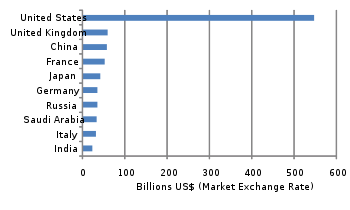Armed forces
The armed forces of a country are its government-sponsored defense, fighting forces, and organizations. They exist to further the foreign and domestic policies of their governing body, and to defend that body and the nation it represents from external and internal aggressors. In some countries paramilitary forces are included in a nation's armed forces. Armed force is the use of armed forces to achieve political objectives.
The study of the use of armed forces is called military science. Broadly speaking, this involves considering offense and defense at three "levels": strategy, operational art, and tactics. All three levels study the application of the use of force in order to achieve a desired objective.
Contents |
Organization
In most countries the armed forces are divided into three or four forces: an army, a navy, an air force, and often a gendarmerie or a paramilitary police force. Gendarmeries (including equivalents such as Internal Troops, Paramilitary Forces, etc.) are common in most of the world but are uncommon in Anglo-Saxon countries. A number of countries have no navy, for geographical reasons.
Many countries have a variation on the standard model of three or four basic forces. Variations include China (army, navy, air force, strategic missile force), South Africa (army, navy, air force, military health service), Egypt (army, navy, air force, air defense) or The Netherlands (army, navy, air force, military police). The United States has five (army, navy, air force, marines, coast guard), like Italy (army, navy, air force, military police and financial police).
In larger armed forces the culture between the different branches of a country's armed forces can be quite different.
Most smaller countries have a single organization that encompasses all armed forces employed by the country in question. Third-world armies tend to consist primarily of infantry, while first-world armies tend to have larger units manning expensive equipment and only a fraction of personnel in infantry units.
The state of readiness of a military organization may be indicated by its alert state.
Armed forces may be organized as standing forces (e.g. regular army), which describes a professional army that is engaged in no other profession than preparing for and engaging in warfare. In contrast, there is the very rare citizen army as used in Switzerland. A citizen army (also known as a militia or reserve army) is only mobilized as needed. Its advantage lies in the fact that it is dramatically less expensive (in terms of wealth, manpower, and opportunity cost) for the organizing society to support. The disadvantage is that such a "citizen's army" is less well trained and organized.
A compromise between the two has a small cadre of professional non-commissioned officers (NCOs) and officers who act as a skeleton for a much larger force. When war comes, this skeleton is filled out with conscripts or reservists (former full-time soldiers who volunteer for a small stipend to occasionally train with the cadre to keep their military skills intact), who form the wartime unit. This balances the pros and cons of each basic organization, and allows the formation of huge armies (in terms of millions of combatants), necessary in modern large scale warfare.
Benefits and costs

The obvious benefit to a country in maintaining armed forces, is in providing protection from foreign threats, and from internal conflict. In recent decades armed forces personnel have also been used as emergency civil support roles in post-disaster situations. On the other hand they may also harm a society by engaging in counter-productive (or merely unsuccessful) warfare.
Expenditure on science and technology to develop weapons and systems sometimes produces side benefits, although some claim that greater benefits could come from targeting the money directly.
Armed forces of the world
See also: Category:Military by country
See also
- Mercenary
- Military organization
- Militaria
- Military fiat
- Military history
- Military incompetence
- Junta
- Military rule
- Military science
- Military Aid to the Civil Power
- Military Aid to the Civil Community
- List of countries by military expenditures
- List of countries by number of active troops
- List of countries by size of armed forces
- List of countries without an army
- List of air forces
- List of navies
- List of armies
- List of battles